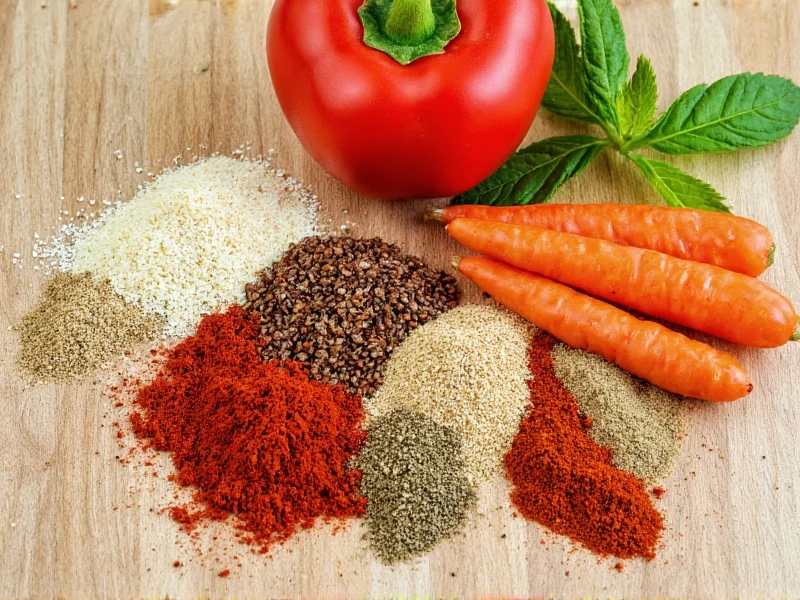Seasoning vegetables properly can transform bland produce into culinary masterpieces. The right spice combinations don't just add flavor—they enhance natural sweetness, balance bitterness, and create complex taste experiences that make vegetables the star of any meal. This guide reveals scientifically backed spice-vegetable pairings that professional chefs use to elevate everyday produce.
Understanding Vegetable-Spice Chemistry
Vegetables contain different flavor compounds that interact uniquely with spices. Sulfur compounds in cruciferous vegetables like broccoli respond well to mustard seeds, while the natural sugars in root vegetables caramelize beautifully with warm spices. When selecting spices for vegetables, consider three key factors: the vegetable's dominant flavor compounds, cooking method, and desired flavor direction (earthy, bright, warm, or herbal).
Comprehensive Vegetable-Spice Pairing Guide
| Vegetable Category | Best Spices | Flavor Chemistry Explanation |
|---|---|---|
| Root Vegetables (carrots, potatoes, beets) | Cumin, coriander, smoked paprika, cinnamon | Warm spices complement natural sugars that intensify during roasting |
| Cruciferous Vegetables (broccoli, cauliflower, Brussels sprouts) | Mustard seeds, turmeric, caraway, garlic powder | Sulfur compounds harmonize with pungent spices; turmeric reduces bitterness |
| Leafy Greens (kale, spinach, chard) | Lemon zest, red pepper flakes, garlic, sumac | Acidic elements balance earthiness; heat enhances nutrient absorption |
| Nightshades (tomatoes, eggplant, peppers) | Oregano, basil, thyme, smoked paprika | Herbal spices complement alkaloid compounds; smoke enhances umami |
| Alliums (onions, leeks, shallots) | Thyme, rosemary, saffron, bay leaves | Floral spices balance sulfur compounds without overwhelming |
Optimal Spice Application Techniques
How you apply spices matters as much as which spices you choose. For roasted vegetables, toss with spices and oil before cooking to allow flavors to penetrate. When sautéing, add dried spices to hot oil first to bloom their flavors before adding vegetables. For raw vegetable preparations, finish with fresh herbs and citrus zest to preserve volatile flavor compounds. Remember that cooking reduces spice intensity by 30-50%, so adjust quantities accordingly.
Creating Signature Spice Blends for Vegetables
Master these versatile vegetable spice combinations:
- Mediterranean Vegetable Blend: 2 parts oregano, 1 part thyme, 1 part rosemary, ½ part lemon zest (perfect for zucchini, eggplant, and tomatoes)
- Root Vegetable Warmth Blend: 2 parts cumin, 1 part smoked paprika, 1 part coriander, ½ part cinnamon (ideal for roasted carrots and sweet potatoes)
- Asian-Inspired Vegetable Blend: 2 parts ginger, 1 part garlic powder, 1 part sesame seeds, ½ part five-spice powder (excellent for stir-fried bok choy and green beans)
Avoiding Common Vegetable Seasoning Mistakes
Many home cooks make these critical errors when seasoning vegetables:
- Adding salt too early in cooking, drawing out moisture before caramelization
- Using only dried herbs with raw vegetable preparations (fresh herbs work better)
- Overpowering delicate vegetables like asparagus with strong spices like cumin
- Not adjusting spice quantities based on cooking method (roasting requires more)
- Adding all spices at once rather than layering flavors throughout cooking
Experimenting with Global Spice Traditions
Explore regional approaches to vegetable seasoning that have evolved over centuries:
Middle Eastern cuisine often uses sumac and za'atar with roasted vegetables, creating bright, tangy profiles that complement the natural sweetness. Indian cooking employs the "tadka" technique—tempering spices in hot oil before adding vegetables—which maximizes flavor extraction. French cuisine favors fines herbes (a mixture of chives, parsley, tarragon, and chervil) with delicate spring vegetables. Understanding these cultural approaches provides endless inspiration for vegetable spice combinations.
Seasoning Vegetables for Specific Dietary Goals
Tailor your spice choices to enhance nutritional benefits:
- Pair turmeric with black pepper and healthy fats to increase curcumin absorption by 2000%
- Combine iron-rich leafy greens with vitamin C-rich spices like lemon zest for better iron absorption
- Use cinnamon with sweet vegetables to moderate blood sugar response
- Add garlic to cruciferous vegetables to enhance cancer-fighting compound formation
Developing Your Palate for Vegetable Seasoning
Become more confident in creating your own vegetable spice combinations by practicing these techniques:
Start with a base of aromatics (onion, garlic, ginger), then add one dominant spice, one complementary spice, and finish with fresh elements. Taste vegetables at different cooking stages to understand how flavors evolve. Keep a seasoning journal noting successful combinations. Most importantly, trust your palate—spice preferences are personal, and what matters most is creating dishes you enjoy. Remember that vegetable quality affects seasoning needs; fresher produce often requires less spice.











 浙公网安备
33010002000092号
浙公网安备
33010002000092号 浙B2-20120091-4
浙B2-20120091-4